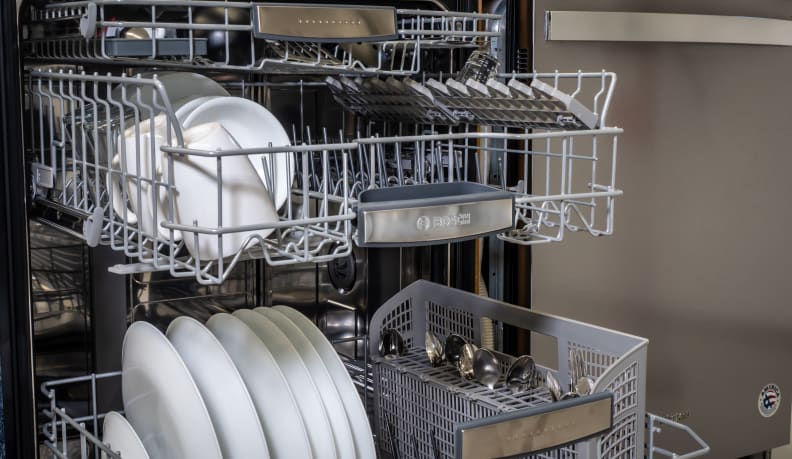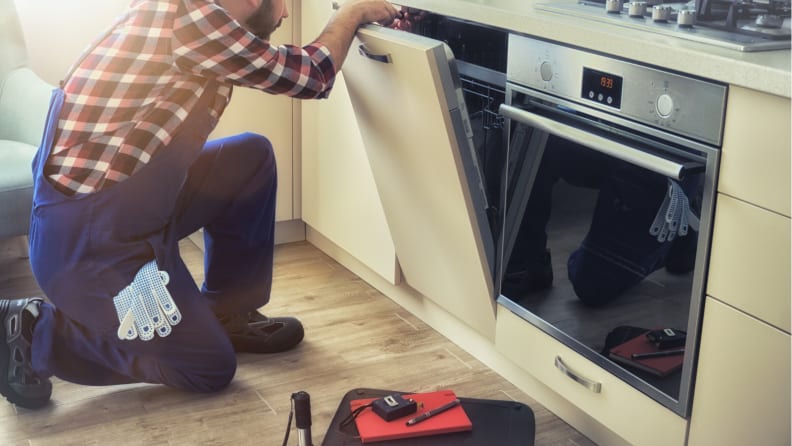How to install a dishwasher (and when to call a pro)
Find out when to do-it-yourself and when to call for help
 Credit:
AndreyPopov / Getty Images
Credit:
AndreyPopov / Getty Images
Recommendations are independently chosen by Reviewed's editors. Purchases made through the links below may earn us and our publishing partners a commission. Prices were accurate at the time this article was published but may change over time.
When my husband and I moved into our house, the first thing we did was replace our oven from the early ’70s. It beeped every hour and had knobs more complicated than an aircraft’s (I assume, I’ve never piloted a plane). Our dishwasher was equally old, and aside from the one time my mother-in-law tried to run it, it hadn’t been touched since we moved in. But after a few weeks, we realized it had to go, too, and we needed to buy a new one.
After searching for the best dishwasher, we finally settled on the GE GDF630PSMSS stainless-steel dishwasher that was quiet, cost-effective, and—frankly—sleek. Once it was picked out, all we had to do was remove the old one and install the new one. Piece of cake.
We were two twentysomethings who had recently bought a fixer-upper. We’d amassed a number of home improvement projects under our belts in our first few months, plus my father is a professional handyman, so expert advice was always a phone call away. We had no doubts we could install a dishwasher on our own. So I hope it comes as no surprise that in the course of installing our own dishwasher, we ended up calling several professionals.
Installing your own dishwasher is an undertaking, and while it’s certainly not impossible, it’s something you should do alongside a great deal of research, an appraisal of your own tool collection, and a great heaping dose of reality, because even if you do it perfectly, you may still need help from the pros.
An important note: While this guide walks you through the basics of installing your own dishwasher, the instructions will be different depending on which model you own. Take the time to carefully read the manual that comes with your new appliance and prepare accordingly.
What to consider before installing your dishwasher

The Bosch 800 Series SHPM88Z75N (2019) is the best dishwasher you can buy.
Before you get your new dishwasher, you’ll want to make sure your kitchen is fully prepped to have the new dishwasher delivered (and the old one removed, if applicable). Start by measuring everything to make sure you have the clearance in your home to have a new appliance delivered, measuring the space where your dishwasher will go to ensure a snug fit, and clearing out enough space in your home to house the new dishwasher while you prepare to install it.
Next, you’ll want to get all the tools you need to complete the job. Your dishwasher delivery will include smaller tools like screws, brackets, and clamps, but you’ll want to have some standard home improvement tools on hand, like a screwdriver, pliers, wrench, measuring tape, power drill, and flashlight.
Finally, you may want to consider calling in a buddy to help you through the process, either physically or emotionally. I was lucky to have a live-in spouse who did all the things I didn’t want to (meaning those that involved moving heavy objects). A delivery team will be able to move the appliances, but a buddy can help trade-off if you’re struggling with a screw, or provide much-needed positive reinforcement throughout the journey.
How to install a dishwasher
What you need:
- Instruction manual
- Parts supplied with your dishwasher
- Phillips-head screwdriver
- Socket wrench
- Adjustable wrench
- Level
- Measuring tape
- Bucket
- Safety glasses
- Gloves
- Neck pillow or supportive back pad
Prep time needed: 1 hour
Total time needed: 2–3 hours
Difficulty: Hard
Step 1: Turn off the water and electricity in your kitchen.
Before you touch your dishwasher, start by cutting off the electricity and water supply to the kitchen. You’ll be removing and adding a new appliance that needs both to work, so you don’t want to risk a water leak or shock during the process.
You’ll want to find your home’s breaker box and turn off the electricity to the kitchen. To turn off your water supply line, find the shutoff valve and ensure it is off. Unplug your dishwasher and disconnect the dishwasher drain hose currently connected under your sink.
Note: There’s probably a good amount of dirty water and food gunk that will spill from the drain hose once you unplug it. Have a bucket ready to catch any excess water draining from the pipe.
Step 2: Evaluate your plumbing situation.
Your dishwasher installation must adhere to local codes and ordinances. First, you will need to figure out how your dishwasher will drain—ours drains through the garbage disposal, which means the drain hose comes from the dishwasher and plugs directly into the disposal. Alternatively, you can drain directly to the water supply pipe under your sink.
If you’ve got a dishwasher installed already, you can usually follow whatever plumbing was there before you started if you feel confident it was installed recently.
Call the pros: If you live in an old home, it may be worth hiring a plumber to come out and ensuring your setup adheres to your state’s requirements. Additionally, if your home has never had a dishwasher before, call a plumber to give you advice on how to properly install the dishwasher and connect it to your water lines.
Step 3: Evaluate your electrical situation.
Most modern dishwashers must connect to a grounded branch circuit, meaning they will need to be permanently grounded or come with a grounding power cord. Some dishwashers are directly wired into the wall instead of plugged into an outlet. You will need to know which connection your new dishwasher has and whether your current setup is properly wired for your state’s ordinances.
Call the pros: If that all sounded like a different language, it’s time to find an electrician. Working with electrical wires is no joke, and if you don’t have the training to fiddle with them, don’t. We called an electrician to come out and provide us with a new electrical connection for our dishwasher, as our house is pretty old and we could tell the appliances had not been touched in a while.
Step 4: Remove your existing dishwasher.
Start by finding and removing your dishwasher’s toekick. The toekick is a metal plate at the base of your dishwasher—it should be easily removed with a screwdriver, and will allow you to see underneath your dishwasher.
Once the toekick is out, you’ll want to unscrew the leveling legs found in each of the four corners of the dishwasher base. You can do this with your arms or an extended wrench, just make sure you start with the legs in the back. By unscrewing the leveling legs, you will create space between your dishwasher and the counter, allowing you to slide the dishwasher out once you’ve created enough.
Call the pros: If you cannot comfortably reach under your dishwasher or get the leveling legs to budge, call a handyman to help.
Step 5: Clean the dishwasher area thoroughly.
Break out your trusty wet vac and clean out the spot where your dishwasher once lived. Over the years, it may have accumulated food waste, dust, or debris, so clean it all out before your new appliance takes its place.
Step 6: Have your new dishwasher delivered.
Once you’ve confidently removed the old dishwasher and gotten control over your plumbing and electrical situation, have your new dishwasher delivered to your home. You can start unpacking the box and setting aside any materials you’ll need later.
Step 7: Read, re-read, then re-read your instruction manual.
Your installation manual will tell you everything your dishwasher requires to be set up properly, but if you’ve never installed an appliance on your own before, you’ll want to read the entire manual, then read it again a few more times. Just like when you work with a new recipe, you’ll want to make sure you understand the entire step-by-step process and have all the materials you need before you find yourself too deep in the process.
Step 8: Start with Step 1 in your manual and get to work.
Depending on the model of your dishwasher, size of the unit, your kitchen’s specs, and a number of other factors, the installation of your specific unit will vary. We highly recommend that you follow each step laid out in your manual from start to finish to ensure you’ve hit every little detail.
Generally, you’ll start by removing the toekick from your new unit, flattening all leveling legs, connecting the drain hose, power, and water, then sliding it partway into the opening in your kitchen. (Note: Higher-end dishwashers come with drain hoses already attached, so you can skip this step.) If your unit comes with trim pieces, you’ll install those next, then use mounting brackets to secure the unit in place. You’ll push the unit into its final place, then readjust the leveling legs.
Before you replace the toekick, you’ll want to turn your plumbing and electrical back on, secure all connections, then run the dishwasher to ensure there are no leaks. For minute drips, you can tighten the connection and then wrap it in plumber's tape.
All final connections and testing should happen before you re-install the toekick, as you’ll still be able to see under the dishwasher and address any issues before they become big problems.
When to call a professional

Know when it's time to call a professional.
If you are uncomfortable working with electricity or plumbing, it’s best to call local professionals for their assistance. Technicians and handymen undergo training to not only work electrical and plumbing systems, but they’re the most up-to-date on state codes and local ordinances.
Personally, my husband and I consider ourselves proficient in home improvement. We’ve installed most of our appliances and done a number of renovation projects without a problem. When installing our dishwasher, we called two professionals: an electrician who re-did the electrical setup in our kitchen, and a GE technician to replace a broken part in our dishwasher. The need for the second professional wasn’t our fault, but he did re-do the drain hose we installed to make it more efficient, which we really appreciated.
So if you’re comfortable tackling difficult home projects, you can likely install a dishwasher on your own without calling too many professionals (especially if you like living that fixer-upper life). But if you want your installation done properly, smoothly, and stress-free, it may be worth hiring the pros to come out and help.



